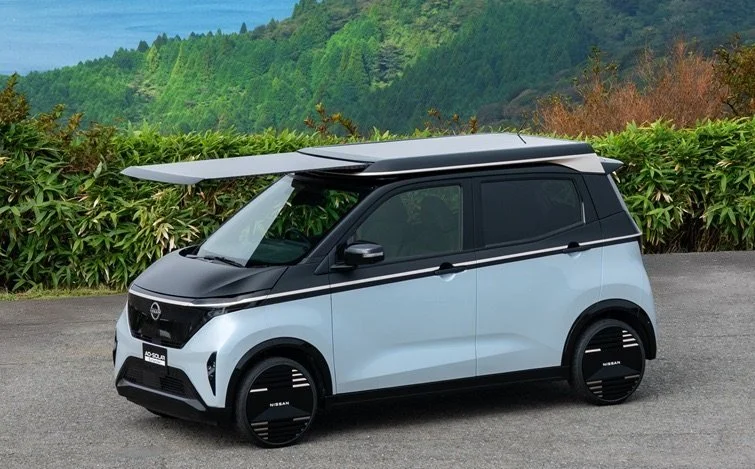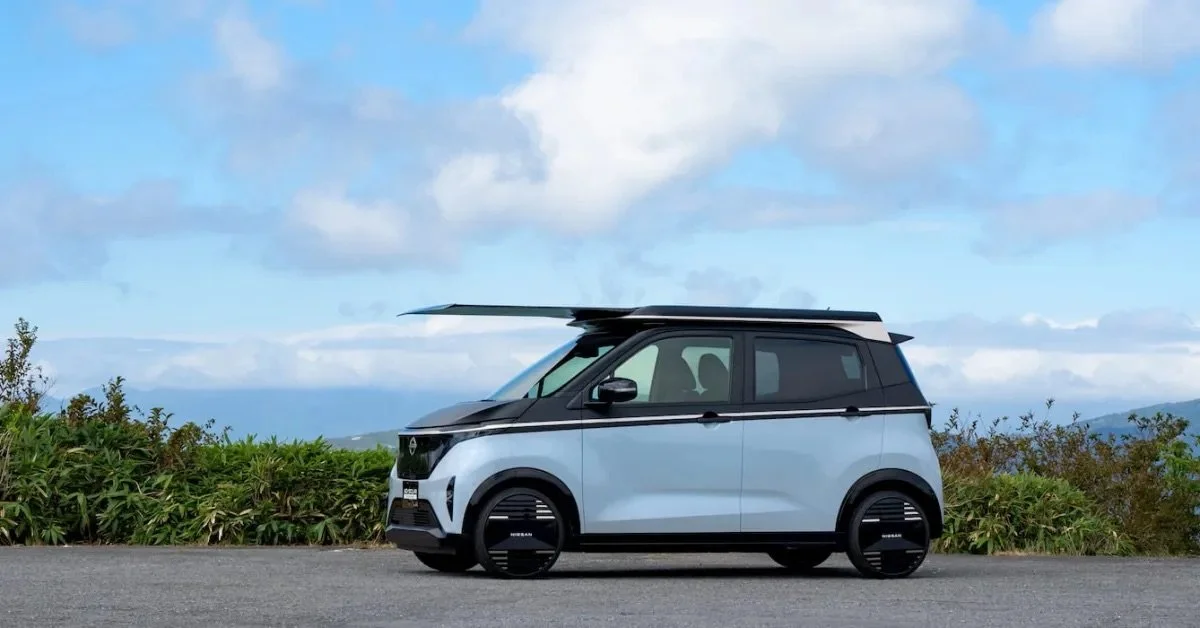Japan’s Best-Selling EV Gets a Solar Boost: Nissan Sakura Adds the ‘Ao-Solar Extender’
Nissan Sakura + Ao-Solar Extender
Nissan gives Japan’s top-selling EV a new source of power
Nissan has unveiled a clever new solar-roof system for the Nissan Sakura, Japan’s best-selling electric vehicle since its launch in 2022. The compact kei EV now features the Ao-Solar Extender, an extendable roof-mounted solar array that can harvest sunlight to add meaningful driving range — without ever plugging in. It’s a practical innovation aimed squarely at Japan’s city-based drivers, where the Sakura already dominates the EV market.
Works in all Weather Conditions
How the Ao-Solar Extender works
When the Sakura is parked, an extra panel slides out from beneath the fixed solar roof, increasing the car’s sun-collecting surface area. This deployable design not only boosts power generation but also shades the windshield, keeping the cabin cooler and reducing the need for air-conditioning once you’re back on the road.
According to Nissan, the system can produce up to 500 W in its extended state, around 300 W while driving, and roughly 80 W even in cloudy or rainy weather. The generated electricity feeds directly into the Sakura’s battery or auxiliary systems, providing extra range and a degree of self-sufficiency — particularly valuable in Japan’s dense urban areas where charging points can be limited.
Nissan Sakura + Ao-Solar Extender
Why it matters
For city drivers, the Ao-Solar Extender offers a real step toward energy independence. Short daily trips could be powered largely by sunlight, cutting electricity costs and reducing reliance on the grid. It’s also potentially useful in Japan’s frequent power outages and disaster scenarios, where self-charging capability could provide a vital backup.
From an industry perspective, this marks an important moment. Extendable solar arrays have been shown on concept cars before, but it’s rare to see a production-ready design on a kei-class EV. Nissan’s move shows how small, affordable vehicles can still lead on innovation and sustainability.
Real-world expectations
In real-world use, Nissan’s “up to 3,000 km per year” solar claim translates to around 300 kWh of extra energy, or roughly 5–6 kWh per week on average — enough for about 60 km of driving in the Sakura. Of course, that figure varies dramatically by season. In winter, when the days are short and sunlight is weaker, owners can expect closer to 20–30 km of free solar range per week, while in summer, with long daylight hours and stronger sun, it can rise to 60–70 km per week. In other words, the Ao-Solar Extender won’t replace charging entirely, but for daily errands, commutes, or short trips — especially if the car is parked outdoors in good light — it could cover a surprising amount of everyday driving without ever plugging in.
A fit for Japan’s lifestyle
Japan’s compact-car culture makes the Sakura a natural platform for solar integration. Most kei cars handle short daily journeys — school runs, shopping, and commutes — and spend hours parked in the open. The Ao-Solar Extender takes advantage of that downtime to quietly harvest energy, lowering running costs and reducing environmental impact. It also aligns neatly with Japan’s wider sustainability goals, complementing the country’s growing emphasis on rooftop solar and home-to-vehicle energy sharing.
Japan’s Best Selling EV, the Nissan Sakura
Looking ahead
Nissan will showcase the Ao-Solar Extender at the Japan Mobility Show 2025, where it’s expected to attract strong attention from both consumers and rival automakers. The company hasn’t yet confirmed production timing or pricing, but if the concept proves durable and cost-effective, similar solar systems could appear on other small EVs — perhaps even as retrofit kits for existing Sakura owners.
Whether the Ao-Solar Extender becomes a mainstream option or remains a niche add-on, it signals a clear direction for the future: EVs that don’t just consume electricity, but also generate it.
Sources
Nissan Global Newsroom — “Ao-Solar Extender for Nissan Sakura”
https://global.nissannews.com/en/releases/ao-solar-extender-for-nissan-sakuraElectrek — “Nissan’s EV solar roof can add 1,800 miles of free driving per year”
https://electrek.co/2025/10/22/nissans-ev-solar-roof-can-add-1800-miles-of-free-driving-per-year/







